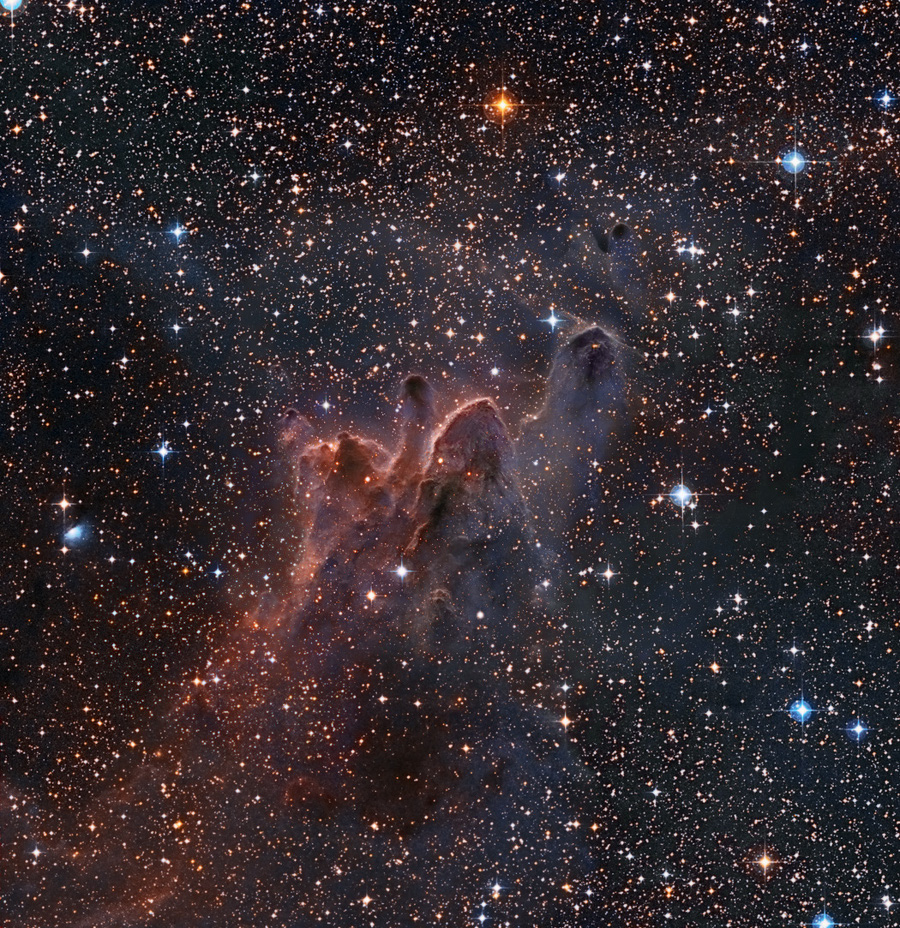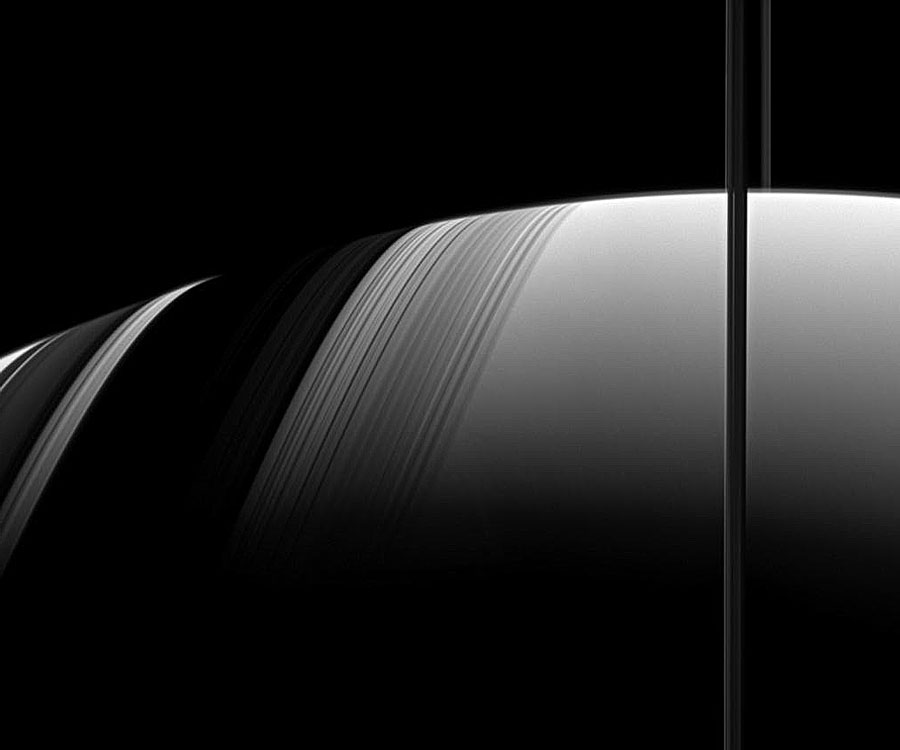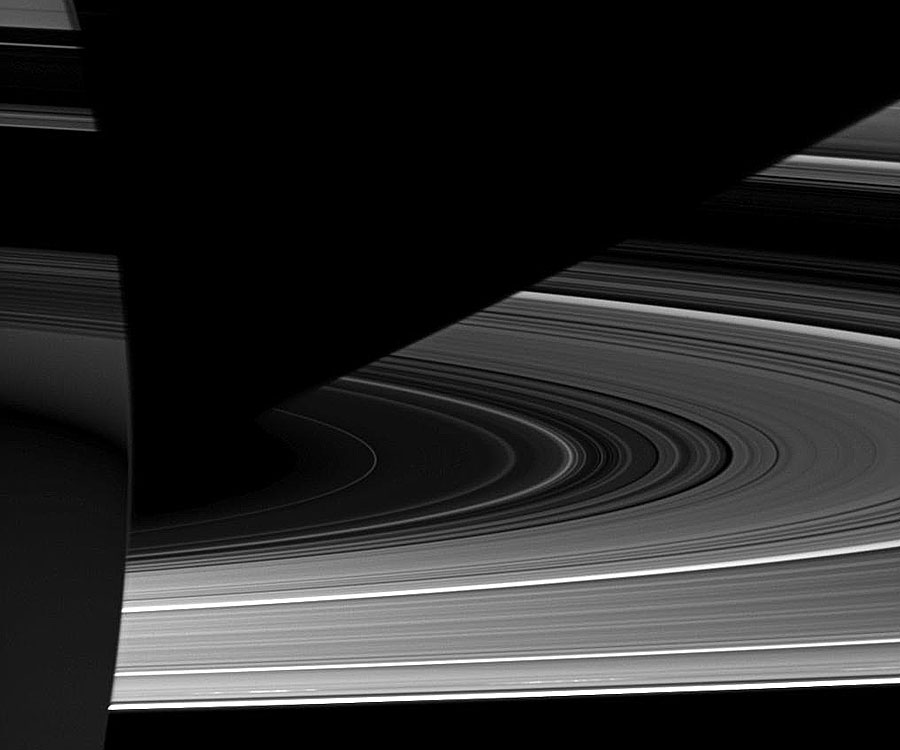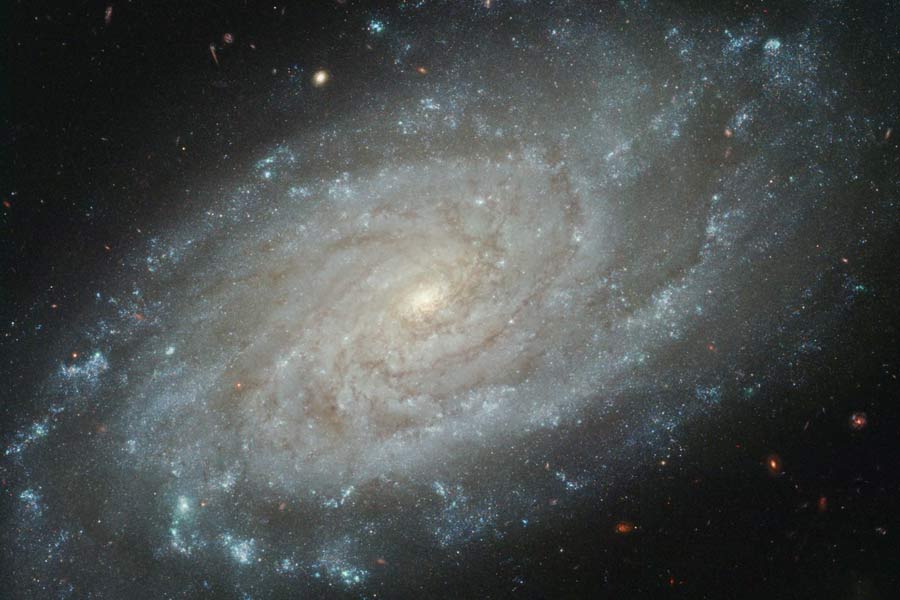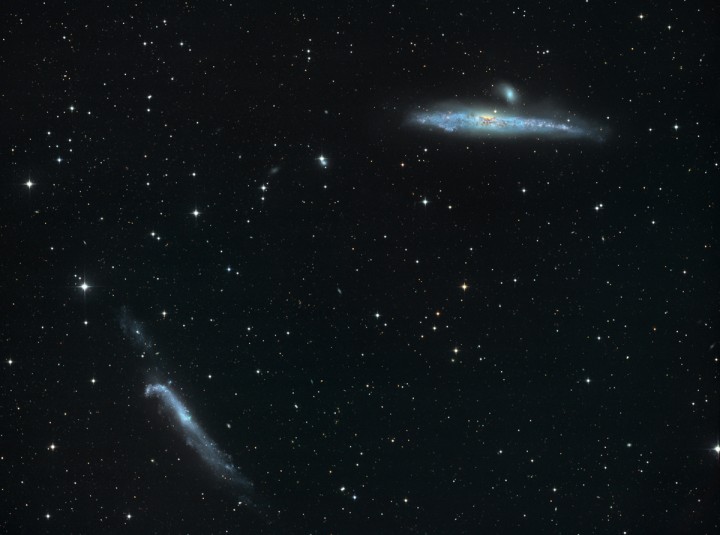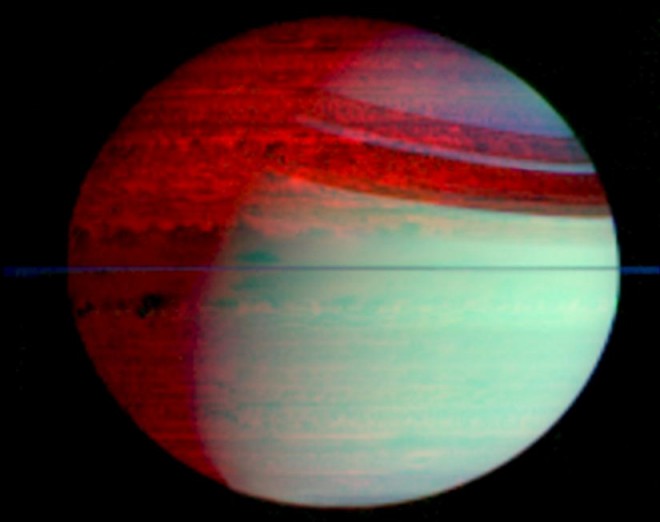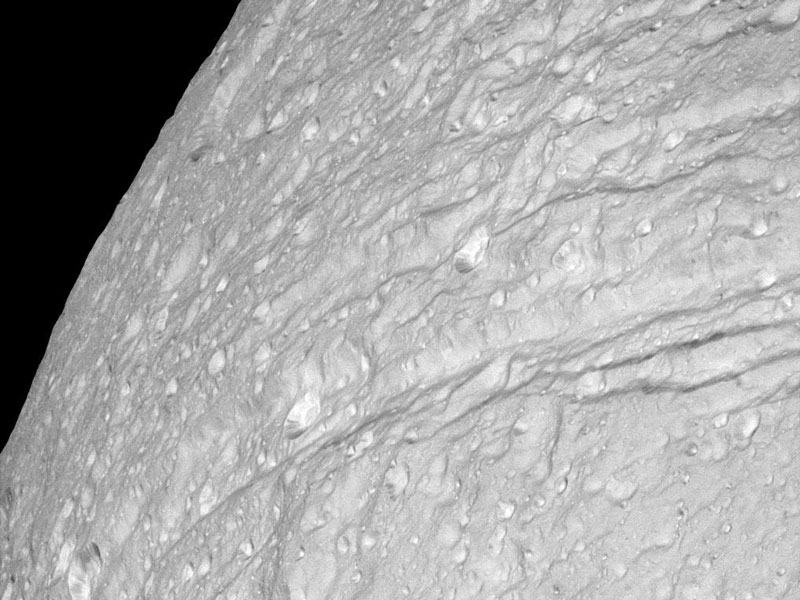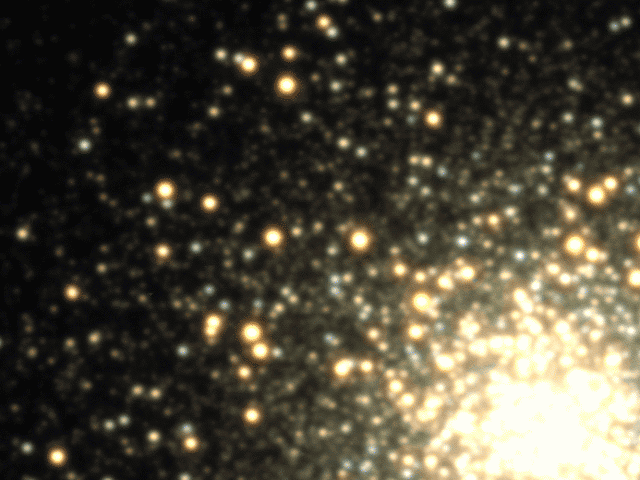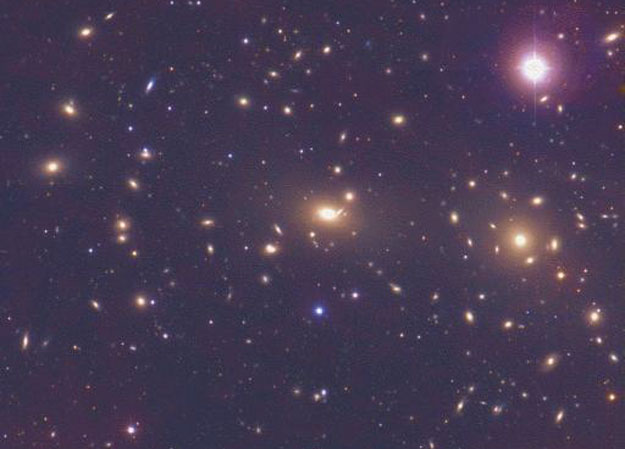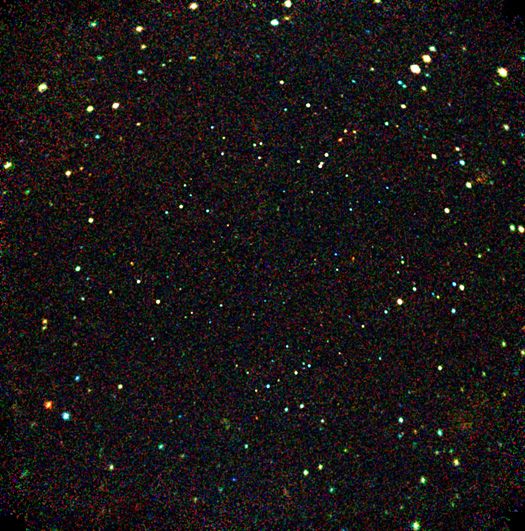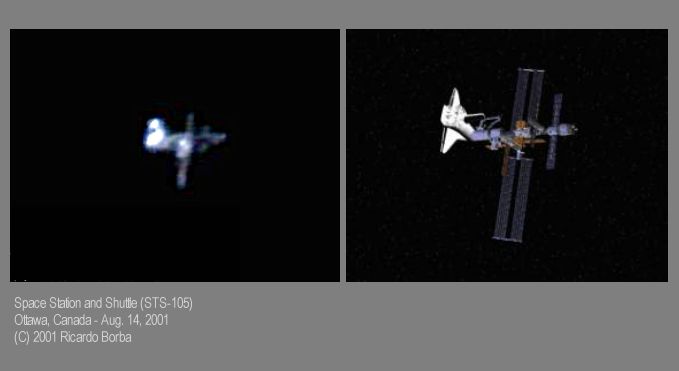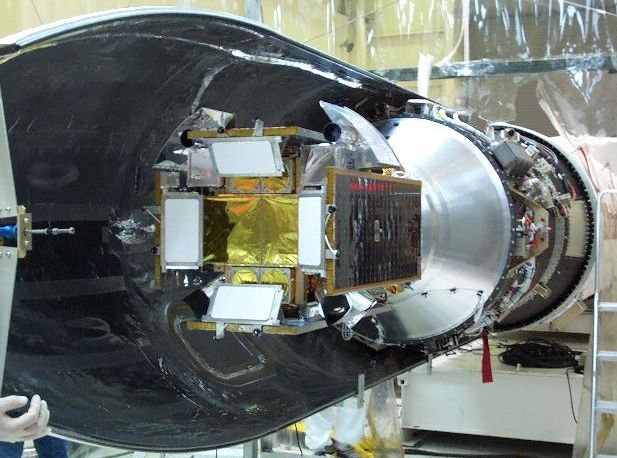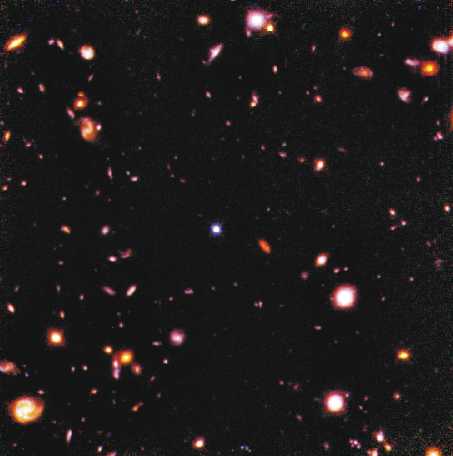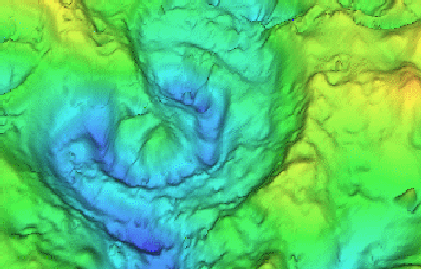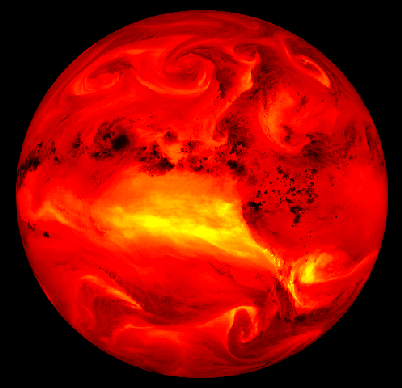| << Previous | Index | Next >> |
2014 How did a star create the Helix nebula? The shapes of planetary nebula like the Helix are important because they likely hold clues to how stars like the Sun end their lives. Observations by the orbiting Hubble Space Telescope and the 4-meter Blanco Telescope in Chile, however, have shown the Helix is not really a simple helix. Rather, it incorporates two nearly perpendicular disks as well as arcs, shocks, and even features not well understood. Even so, many strikingly geometric symmetries remain. How a single Sun-like star created such beautiful yet geometric complexity is a topic of research. The Helix Nebula is the nearest planetary nebula to Earth, lies only about 700 light years away toward the constellation of Aquarius, and spans about 3 light-years.
2013 Bright-rimmed, flowing shapes gather near the center of this rich starfield toward the boarders of the nautical southern constellations Pupis and Vela. Composed of interstellar gas and dust, the grouping of light-year sized cometary globules is about 1300 light-years distant. Energetic ultraviolet light from nearby hot stars has molded the globules and ionized their bright rims. The globules also stream away from the Vela supernova remnant which may have influenced their swept-back shapes. Within them, cores of cold gas and dust are likely collapsing to form low mass stars, whose formation will ultimately cause the globules to disperse. In fact, cometary globule CG30 (upper right in the group) sports a small reddish glow near its head, a telltale sign of energetic jets from a star in the early stages of formation.
2012
2011 Saturn's rings form one of the larger sundials known. This sundial, however, determines only the season of Saturn, not the time of day. In 2009, during Saturn's last equinox, Saturn's thin rings threw almost no shadows onto Saturn, since the ring plane pointed directly toward the Sun. As Saturn continued in its orbit around the Sun, however, the ring shadows become increasingly wider and cast further south. These shadows are not easily visible from the Earth because from our vantage point near the Sun, the rings always block the shadows. The above image was taken in August by the robotic Cassini spacecraft currently orbiting Saturn. The rings themselves appear as a vertical bar on the image right. The Sun, far to the upper right, shines through the rings and casts captivatingly complex shadows on south Saturn, on the image left. Cassini has been exploring Saturn, its rings, and its moons since 2004, and is expected to continue until at least the maximum elongation of Saturn's shadows occurs in 2017.
2010 What's creating those dark bands on Saturn? Sometimes it takes a little sleuthing to figure out the how and why of a picture taken by the Saturn-orbiting Cassini spacecraft. Let's see. That large orb on the left must be Saturn itself. Those arcs on the right are surely the rings. The dark band running diagonally must be the shadow of Saturn on the rings. That leaves the unusual dark bands superposed on Saturn's disk -- are they the shadows of the rings? A punctilious detective would conclude that they are not. If one looks carefully, the rings arc from behind the planet on the lower left, around to the right, and therefore must pass on the camera side of the planet on the upper left. So the rings themselves cause the dark streaks on Saturn. These rings segments appear dark because they are in the shadow of Saturn. The night part of Saturn shows a faint glow because of sunlight reflected from other parts of the rings. Got it? Unfortunately, if it weren't for the tile floor, tomorrow's picture would be even harder to understand.
2009 Why were the statues on Easter Island built? No one is sure. What is sure is that over 800 large stone statues exist there. The Easter Island statues, stand, on the average, over twice as tall as a person and have over 200 times as much mass. Few specifics are known about the history or meaning of the unusual statues, but many believe that they were created about 500 years ago in the images of local leaders of a lost civilization. Pictured above, a large stone statue appears to ponder the distant Large Magellanic Cloud before a cloudy sky that features the bright stars Canopus and Sirius.
2008 Is this what our own Milky Way Galaxy looks like from far away? Similar in size and grand design to our home Galaxy (although without the central bar), spiral galaxy NGC 3370 lies about 100 million light-years away toward the constellation of the Lion (Leo). Recorded above in exquisite detail by the Hubble Space Telescope's Advanced Camera for Surveys, the big, beautiful face-on spiral is not only photogenic, but has proven sharp enough to study individual stars known as Cepheids. These pulsating stars have been used to accurately determine NGC 3370's distance. NGC 3370 was chosen for this study because in 1994 the spiral galaxy was also home to a well studied stellar explosion -- a Type Ia supernova. Combining the known distance to this standard candle supernova, based on the Cepheid measurements, with observations of supernovas at even greater distances, has helped to reveal the size and expansion rate of the entire Universe itself.
2007 NGC 4631 is a big beautiful spiral galaxy seen edge-on (top right) only 25 million light-years away towards the small northern constellation Canes Venatici. This galaxy's slightly distorted wedge shape suggests to some a cosmic herring and to others the popular moniker of The Whale Galaxy. Either way, it is similar in size to our own Milky Way. In this gorgeous color image, the Whale's dark interstellar dust clouds, yellowish core, and young blue star clusters are easy to spot. A companion galaxy, the small elliptical NGC 4627, appears above the Whale Galaxy. At the lower left is another distorted galaxy, the hockey stick-shaped NGC 4656. The distortions and mingling trails of gas detected at other wavelengths suggest that all three galaxies have had close encounters with each other in their past. The Whale Galaxy is also known to have spouted a halo of hot gas glowing in x-rays.
2006 Known for its bright ring system and many moons, gas giant Saturn looks strange and unfamiliar in this false-color view from the Cassini spacecraft. In fact, in this Visual and Infrared Mapping Spectrometer (VIMS) mosaic the famous rings are almost invisible, seen edge-on cutting across picture center. The most striking contrast in the image is along the terminator or boundary between night and day. To the right (day side) blue-green hues are visible sunlight reflected from Saturn's cloud tops. But on the left (night side) in the absence of sunlight, the lantern-like glow of infrared radiation from the planet's warm interior silhouettes features at Saturn's deeper cloud levels. The thermal infrared glow is also apparent in the broad bands of ring shadows draped across the northern hemisphere of Saturn.
2005 The surface of Saturn's moon Tethys is riddled with icy cliffs and craters. The most detailed images ever taken of Tethys were captured late last month as the robot Cassini spacecraft swooped past the frozen ice moon. The above image was taken from about 32,000 kilometers distant and shows a jagged landscape of long cliffs covered with craters. At the bottom of many craters appears some sort of unknown light-colored substance, in contrast to the unknown dark substance that appears at the bottom of Saturn's moon Hyperion. Tethys is one of the larger moons of Saturn, spanning about 1,000 kilometers across. The density of Tethys indicates a composition almost entirely of water ice. Tethys is thought to have been predominantly liquid sometime in its distant past, creating some of its long ice-cliffs as it cracked during freezing.
2004 Star clusters appear constant because photographs of them are frozen in time. In reality, though, cluster stars swarm the center and frequently fluctuate in brightness. Although the time it takes for stars to cross a cluster is about 100,000 years, the time it takes for a star to fluctuate noticeably can be less than one night. In fact, the above time lapse movie of bright globular cluster M3 was taken over a single night. Most of the variable stars visible above are RR Lyrae stars, stars that can quickly double their brightness while becoming noticeably bluer. Furthermore, RR Lyrae stars vary their light in a distinctive pattern that allows unique identification. Lastly, since RR Lyrae stars all have the same intrinsic brightness, identifying them and measuring how dim they appear tells how far they are, since faintness means farness. These distances, in turn, help calibrate the scale of the entire universe.
2003 Almost every object in the above photograph is a galaxy. The Coma Cluster of Galaxies pictured above is one of the densest clusters known - it contains thousands of galaxies. Each of these galaxies houses billions of stars - just as our own Milky Way Galaxy does. Although nearby when compared to most other clusters, light from the Coma Cluster still takes hundreds of millions of years to reach us. In fact, the Coma Cluster is so big it takes light millions of years just to go from one side to the other! Most galaxies in Coma and other clusters are ellipticals, while most galaxies outside of clusters are spirals. The nature of Coma's X-ray emission is still being investigated.
2002 Officially the Chandra Deep Field - South, this picture represents the deepest ever x-ray image of the Universe. One million seconds of accumulated exposure time with the orbiting Chandra X-ray Observatory went in to its making. Concentrating on a single, otherwise unremarkable patch of sky in the constellation Fornax, this x-ray image corresponds to the visible light Hubble Deep Field - South released in 1998. Chandra's view, color coded with low energies in red, medium in green, and high-energy x-rays in blue, shows many faint sources of relatively high-energy x-rays. These are likely active galaxies feeding supermassive central black holes and large clusters of galaxies at distances of up to 12 billion light-years. The stunning picture supports astronomers' ideas of a youthful universe in which massive black holes were much more dominant than at present.
2001 Knowing when and where to look, many enthusiastic sky gazers have been able to spot the International Space Station (ISS) as a bright star streaking through the twilight. But with a digital camera and a small telescope, recognizable images are possible too. Astronomer Ricardo Borba offers this example of the Space Shuttle Discovery docked with the ISS, recorded this August from his backyard in Ottawa, Canada. Operating a digital video camera on an 8 inch reflecting telescope, Borba tracked the Earth-orbiting pair by hand. Unwanted telescope motion and atmospheric blurring caused most of the video frames to be indistinct, still the single best frame (left) from his video sequence is amazingly sharp. For comparison, he constructed a computer generated image (right) showing the approximate orientation of the Shuttle/ISS docking configuration based on virtual 3D models available on the web.
2000 The Stargazer, a modified Lockheed L-1011 aircraft, soared into the skies above Kwajalein Atoll in the pacific on October 9th. A small satellite observatory known as the High Energy Transient Explorer - 2 (HETE-2) was tucked into Stargazer's winged Pegasus rocket, slung beneath the large trimotor jet's fuselage. Dropped from its mother ship, the Pegasus then successfully flew HETE-2 into orbit. HETE-2's mission is to hunt gamma-ray bursts, brief, random flashes of high energy photons from the distant cosmos. Gamma-ray bursts are impressive, believed to be the most powerful explosions in the Universe, but so few have been well located and studied that the nature of the bursters themselves is still shrouded in mystery. HETE-2's x-ray and gamma-ray instruments will be able to rapidly alert ground-based observatories to point toward ongoing, bright gamma-ray bursts. Communications antennae and solar panels neatly folded, HETE-2 is seen here being carefully enclosed in the Pegasus nose fairing.
1999
1998 Galaxies this faint have never been seen before. In 1996 the Hubble Space Telescope (HST) created one of the most famous pictures of modern astronomy, the Hubble Deep Field (HDF). Now HST has returned to a piece of the HDF for a long exposure by its new NICMOS camera, sensitive to infrared light. The resulting image, shown above in representative color, shows known galaxies in a new light, and previously unknown galaxies probably farther than anything ever seen before. Galaxies as dim as magnitude 30 are visible. Astronomers are learning from the HDF how different the young universe was from the familiar universe of today.
1997 What killed the dinosaurs? Their sudden disappearance 65 million years ago, along with about 70 percent of all species then living on Earth, is known as the K-T event (Cretaceous-Tertiary Mass Extinction event). Geologists and paleontologists often entertain the idea of a large asteroid or comet impacting the Earth as the culprit. Besides the firestorms, tidal waves, earthquakes, and hurricane winds such an impact would generate, the debris thrown into the atmosphere would have a serious global environmental impact -- creating extended periods of darkness, low temperatures, and acid rains. In 1990, dramatic support for this theory came from cosmochemist Alan Hildebrand's revelation of a 65 million year old, 112 mile wide ring structure still detectable under layers of sediment in the Yucatan Peninsula region of Mexico. The outlines of the structure, called the Chicxulub crater (named for a local village), are visible in the above representation of gravity and magnetic field data from the region. In addition to having the right age, the crater is consistent with the impact of an asteroid of sufficient size (6 to 12 miles wide) to cause the global disruptions. Regardless of the true cause of the K-T event, it is fortunate that such impacts are presently believed to happen only about once every 100 million years!
1996 What alien planet's bizarre landscape lurks below these fiery-looking clouds? It's only Planet Earth, of course -- as seen on the Water Vapor Channel. Hourly, images like this one (shown in false color) are brought to you by the orbiting GOES 8 satellite's multi-channel imager. This instrument can produce images at the infrared wavelength of 6.7 microns or about 10 times the wavelength of visible light, recording radiation emitted by water vapor in the upper troposphere. Bright regions correspond to high concentrations of water vapor while dark spots are relatively dry areas. Atmospheric water vapor is invisible to the eye and produced by evaporation from the oceans. Convected upward in the tropical zones it affects the climate by contributing substantially to the greenhouse effect.
1995 The star masked by a dust cloud at the left of the above photo is expelling an energetic beam of charged particles into interstellar space. This jet, moving from left to right, has burrowed through much interstellar material, and now expands out into the interstellar space. Although jet particles move at nearly three hundred kilometers per second , we still do not see any daily movement because of the enormous distances involved. In fact, the jet is trillions of kilometers long. This stellar jet occurs in a system called HH-47 which is located near the edge of the Gum Nebula.
| << Previous | Index | Next >> |

